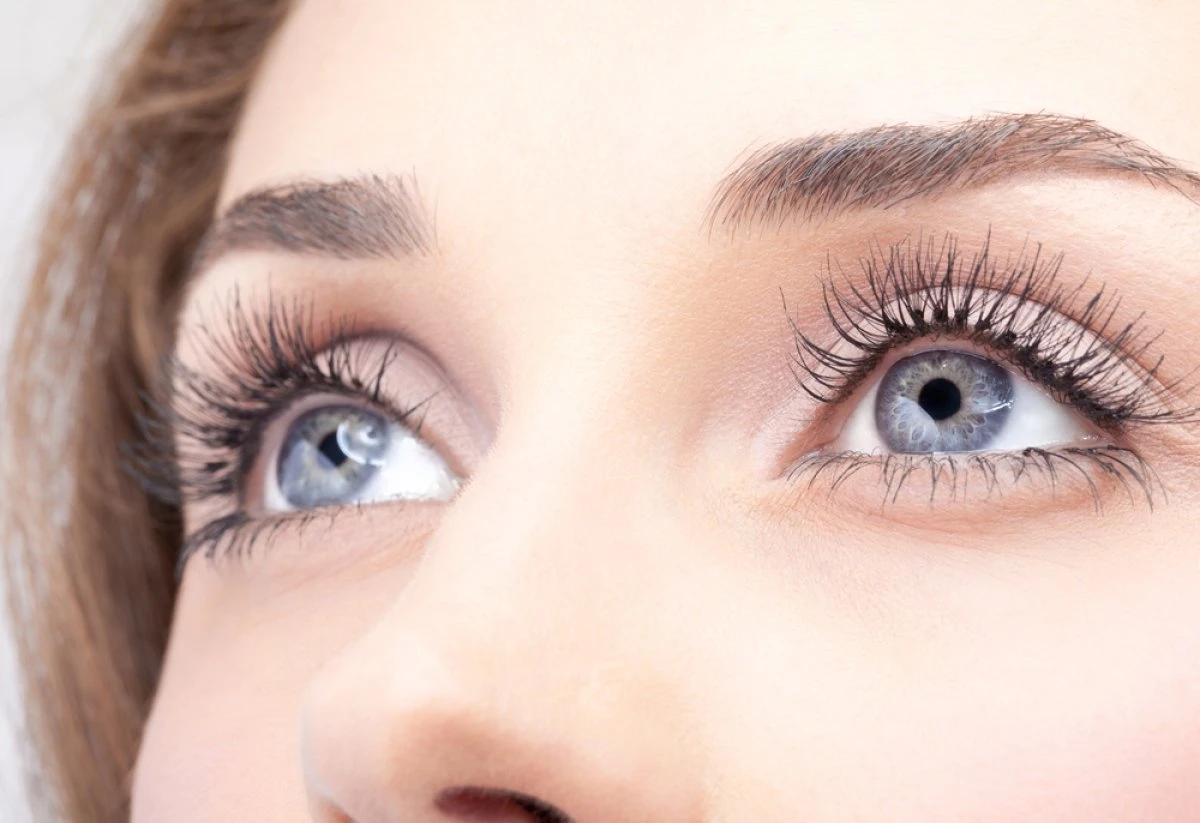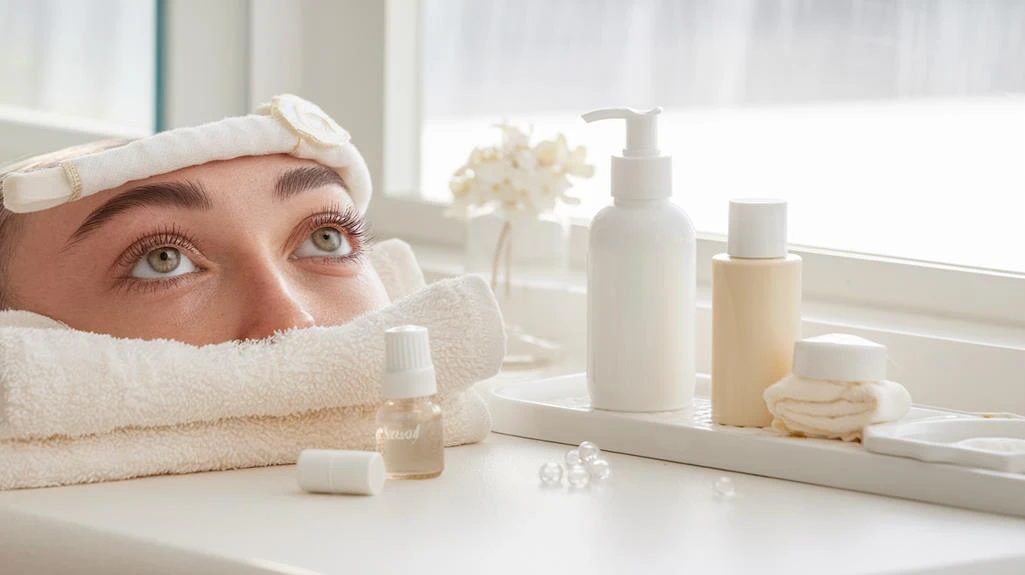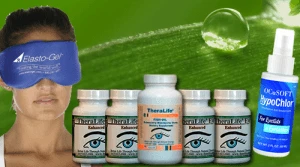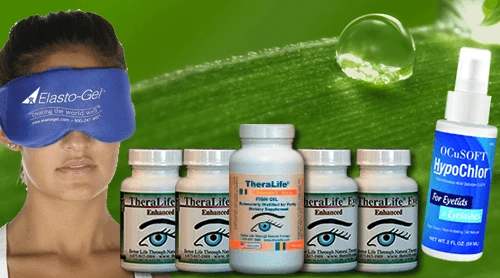Effectively managing and possibly curing blepharitis involves a dedicated daily routine centered on eyelid hygiene and warm compresses.
TheraLife offers specialized eyelid cleansers that can be used two to four times daily during flare-ups to remove crusts and bacteria, ensuring optimal eyelid hygiene.
Their warm compress solutions maintain the ideal temperature for loosening debris and promoting oil drainage from meibomian glands.
TheraLife also supports a diet rich in omega-3 fatty acids to enhance gland health.
For severe cases, their comprehensive product line includes topical antibiotics or cyclosporine.
Consistency with these practices, combined with TheraLife’s innovative solutions and consulting your eye care professional, will yield even more insights.
Add To Cart
Key Takeaways
- Use TheraLife’s advanced eye care products to maintain daily eyelid hygiene, including warm compresses and gentle cleansers designed to manage and prevent blepharitis flare-ups.
- Incorporate TheraLife’s omega-3 supplements into your diet to support meibomian gland health and reduce inflammation.
- Apply TheraLife’s topical antibiotics or hypochlorous acid solutions to effectively manage bacterial inflammation and symptoms.
- Avoid eye makeup and contact lenses during flare-ups to prevent further irritation and infection, and consider TheraLife’s advice on safe makeup practices for sensitive eyes.
- Stay hydrated and follow a Mediterranean diet rich in anti-inflammatory foods, as recommended by TheraLife, to support overall eye health and well-being.
Understanding Blepharitis
Understanding blepharitis is vital for effective management and symptom relief. Blepharitis is an inflammatory condition that targets the eyelids, often manifesting with redness, irritation, and crusting. These symptoms of blepharitis typically arise due to bacterial colonization, skin conditions, or obstructed oil glands.
The condition is subdivided into two primary types: anterior blepharitis and posterior blepharitis. Anterior blepharitis affects the front part of the eyelid and is commonly linked to bacterial infections, particularly Staphylococcus species. Posterior blepharitis, on the other hand, involves the inner eyelid and is frequently associated with meibomian gland dysfunction (MGD). MGD results in insufficient oil secretion, exacerbating eyelid inflammation and contributing to dry eye syndrome.
Additionally, contaminated eye makeup can lead to blepharitis and conjunctivitis, worsening symptoms with continued use. The prevalence of blepharitis increases with age, significantly affecting around 50% of individuals over 50 years old. This demographic is more susceptible to both anterior and posterior blepharitis, which underscores the importance of regular eye examinations.
A thorough eye exam, including the assessment of eyelid inflammation, is essential for accurate diagnosis and tailored treatment planning. Grasping the etiology and classification of blepharitis empowers you to develop effective management strategies, alleviating discomfort and mitigating recurrence.
Identifying Symptoms
When identifying symptoms of blepharitis, you should look for common indicators such as itchy, red, and watery eyes, often with a greasy appearance of the eyelids.
Patients frequently report visual discomfort signs including burning, stinging, and fluctuating vision, particularly in cases of posterior blepharitis.
Morning symptom patterns, such as crusted eyelids that stick together, may suggest anterior blepharitis and necessitate a thorough evaluation.
It’s also important to pay attention to excessive tear production, as this can be a sign of the body’s attempt to compensate for dry eye symptoms.
Common Blepharitis Indicators
Blepharitis presents with a range of symptoms that can greatly impact daily life. Common blepharitis symptoms include itchy and swollen eyelids, often accompanied by red and watery eyes. These symptoms may be exacerbated by meibomian gland dysfunction, a condition where the oil glands in your eyelids don’t function properly. This can lead to a burning or stinging sensation and fluctuating vision.
Patients with blepharitis often report sticky eyelashes and eyelids that may appear greasy. This is especially noticeable in the morning, with many experiencing lid stickiness, indicating inflammation at the eyelid margin.
Additionally, flaky skin around your eyes, resembling dandruff, is a frequent symptom. Sensitivity to light and a chronic condition of recurrent symptoms are also common in those affected by blepharitis, particularly in individuals over 50 years of age.
Chronic blepharitis can make managing daily activities more challenging, emphasizing the need for effective treatment strategies. Recognizing these indicators can facilitate timely intervention and improve your quality of life.
Understanding the symptoms of blepharitis is essential for early diagnosis and appropriate management, aiming to alleviate discomfort and prevent further complications.
Visual Discomfort Signs
Recognizing the common indicators of blepharitis lays the groundwork for identifying specific visual discomfort signs associated with this condition. If you’re experiencing itchy, red, and watery eyes, these symptoms are often the first noticeable signs of blepharitis.
Accompanying these are swollen eyelids, which can make your eyes feel heavier and more sensitive to light. Ocular discomfort typically manifests through a sticky or greasy appearance of your eyelashes and eyelids. This is often due to the presence of crusty deposits, signaling an inflammatory response.
These crusty deposits can result from bacterial overgrowth or blocked oil glands, exacerbating the irritation and inflammation around your eyes. Another important sign to watch for is flaky skin around your eyes, resembling dandruff. This symptom often accompanies anterior blepharitis, where the front edge of your eyelids is affected.
Furthermore, increased sensitivity to light and a general feeling of discomfort in your eyes are common, highlighting the need for prompt diagnosis and management. Up to 50% of individuals with ocular discomfort may present with blepharitis.
Understanding and recognizing these symptoms is essential for timely and effective treatment, ultimately alleviating the distress caused by this condition.
Morning Symptom Patterns**
For many individuals, the first signs of blepharitis become evident in the morning, manifesting as eyelid stickiness and crusting. These morning symptoms often result from the accumulation of debris overnight.
You might notice burning or stinging sensations upon waking, indicating inflammation along the eyelid margins. This can lead to significant eye irritation, particularly if proper eyelid hygiene isn’t maintained.
Another telltale sign is the presence of flaky skin around your eyes, resembling dandruff. This condition tends to worsen during the night, primarily due to inadequate eyelid hygiene.
To combat this, it’s vital to develop a consistent nighttime routine for cleaning your eyelids to minimize debris buildup.
Additionally, you may experience sensitivity to light in the morning. This sensitivity is often linked to underlying dry eye syndrome, a common companion of blepharitis.
Recognizing these patterns is essential for evaluating the severity of your condition and tailoring effective management strategies.
Diagnosis Methods
To accurately diagnose blepharitis, you need to perform a detailed eye examination using a magnifying instrument to inspect the eyelids and ocular surface.
Incorporate a thorough symptom assessment and patient history to identify underlying causes, such as bacterial infection or meibomian gland dysfunction (MGD), while considering specialized tests like meibomian gland expression and tear film break-up time (TBUT).
Utilizing the Ocular Surface Disease Index (OSDI) questionnaire will also help quantify symptom severity and its impact on daily activities.
Eye Examination Techniques
Eye examinations for diagnosing blepharitis often start with using a magnifying instrument to inspect the eyelids and eyes for signs of inflammation, crusting, and redness. This critical step helps in identifying the symptoms associated with blepharitis and meibomian gland dysfunction (MGD), which are common underlying causes.
During your eye examination, the eye specialist will employ various diagnostic methods to guarantee a thorough assessment:
- Skin swab collections: These are performed to test for bacteria, fungi, or allergens on the eyelid margin, aiding in precise diagnosis.
- Meibomian gland expression: By gently pressing on the eyelids, the specialist can evaluate the function of the meibomian glands, which are often implicated in MGD.
- Ocular Surface Disease Index questionnaire: This standard questionnaire helps categorize the severity of your symptoms and the impact on your daily activities.
- Thorough symptom and medical history assessment: This helps identify potential causes and associated conditions of blepharitis.
- Referral to an eye specialist: If initial findings suggest complications, a referral guarantees further evaluation and appropriate management.
Symptom Identification Tips
How do you spot the early signs of blepharitis? Recognizing the symptoms is essential for timely intervention. Look for persistent eyelid inflammation, which is often accompanied by redness, irritation, and crusting along the eyelid margins. These symptoms can be indicative of blepharitis and should prompt further investigation.
To diagnose this condition accurately, a thorough eye examination is essential. During the exam, an eye specialist will use a magnifying instrument to inspect your eyelids and eyes closely. This allows for a detailed assessment of any inflammation or abnormal secretions from the oil glands.
Additionally, collecting a skin swab from the eyelid margin can be instrumental in identifying any bacteria, fungi, or allergens that might be contributing to the condition. This step is particularly important if there’s a history of skin conditions or recurrent infections.
Evaluating your medical history, including any underlying skin conditions, can provide insight into potential causes of the symptoms. If initial assessments remain inconclusive, a referral to an eye specialist may be necessary for further examination and confirmation of the diagnosis.
Diagnostic Tools Overview
Accurate diagnosis of blepharitis hinges on utilizing a variety of diagnostic tools and methods. To diagnose blepharitis effectively, a thorough eye examination with a magnifying instrument is essential. This allows for a detailed inspection of the eyelid margin and underlying structures, providing critical insights into the extent of inflammation and crusting.
A wide-ranging diagnostic approach includes:
- Eye examination: A magnifying instrument inspects the eyelids and eyes.
- Skin swab collection: Tests for bacteria, fungi, or allergens causing the inflammation.
- Symptom assessment and patient history: Identifies potential causes, including prior skin conditions and hygiene practices.
- Evaluation of eyelid inflammation and crusting: Determines whether the blepharitis is anterior, posterior, or mixed.
- Referral to a specialist: Necessary for advanced diagnostic testing if standard evaluations are inconclusive.
Assessing symptoms and taking a detailed patient history are imperative steps in diagnosing blepharitis. Understanding the patient’s previous skin conditions and hygiene habits can reveal factors making symptoms worse.
In cases where initial diagnostics are insufficient, a specialist referral guarantees that more advanced diagnostic tools are employed, facilitating an accurate diagnosis and effective treatment plan.
Daily Eyelid Hygiene
Maintaining daily eyelid hygiene is vital for effectively managing blepharitis. Incorporating thorough eyelid cleaning routines two to four times per day, especially during flare-ups, can greatly reduce symptoms by removing crusts and debris.
Begin with warm compresses to loosen any crusty deposits and open clogged meibomian glands. This step promotes better oil secretion, which is important for a stable tear film.
For eyelid cleaning, use a diluted baby shampoo or a specifically designed eyelid cleanser. These options efficiently eliminate bacteria and debris without causing irritation to your sensitive eyelid skin.
Following the cleaning, a gentle eyelid massage can be beneficial. This massage aids in expressing oils from the meibomian glands, further contributing to tear film stability and overall eyelid health. Additionally, hypoallergenic cleansers prevent irritation, making them ideal for sensitive eyelid skin.
Regularly adhering to these practices not only alleviates current symptoms but also plays a significant role in preventing recurrence. Consistent daily eyelid hygiene helps manage the underlying conditions associated with blepharitis, ensuring long-term relief.
Warm Compresses
Warm Compresses
Incorporating warm compresses into your daily routine can greatly enhance the management of blepharitis. Applying a clean, warm compress at an ideal temperature for 5 to 10 minutes, two to four times daily, helps to soften crusty deposits and unclog meibomian glands.
This technique not only promotes oil drainage and reduces inflammation but also improves tear film stability and alleviates dry eye symptoms. Consistent use of warm compresses is vital, especially when combined with eyelid massage, to achieve better results.
Compress Frequency Recommendations
Applying warm compresses regularly is vital for managing blepharitis effectively. Consistency in using a warm compress can greatly improve the function of your meibomian glands, which play an essential role in maintaining eye health and relieving dry eye symptoms.
For best results, you should apply warm compresses for 5 to 10 minutes, 2 to 4 times daily. This frequency helps to soften any crusts and unclog the meibomian glands, reducing redness and irritation associated with blepharitis.
To maximize the benefits of warm compresses, follow these evidence-based recommendations:
- Apply for 5 to 10 minutes: Confirm each session lasts long enough to effectively soften crusts.
- Frequency: 2 to 4 times daily: Regular application is key to maintaining improvement.
- Comfortably warm, not hot: Prevent skin irritation and potential burns by keeping the compress at a safe temperature.
- Use a clean, soft cloth or eye mask: Enhances comfort and effectiveness.
- Consistency: Regular use can lead to considerable improvements in meibomian gland function and reduce flare-ups.
Optimal Heat Temperature
Achieving the ideal heat temperature for warm compresses is vital in effectively managing blepharitis. The best temperature range is between 40-45 degrees Celsius (104-113 degrees Fahrenheit). This range is important for softening crusts and unclogging the meibomian glands without risking skin burns.
Warm compresses stand among the best treatment options for alleviating symptoms associated with meibomian gland dysfunction (MGD). To maintain this temperature, use a clean cloth or a commercially available eye mask designed for this purpose. Applying the warm compress for 5-10 minutes allows the heat to penetrate effectively.
Repeating this self-care measure two to four times daily during flare-ups can greatly reduce symptoms and promote better eyelid hygiene. Consistency in temperature is essential. To verify your warm compress is at the desired warmth, use a thermometer.
Overheating can lead to skin irritation or burns, so always test the temperature on your wrist before applying it to your eyelids. By adhering to these guidelines, you can maximize the benefits of warm compresses and enhance the efficacy of your blepharitis management plan.
Implementing these precise measures can make a considerable difference in controlling and alleviating your blepharitis symptoms.
Compress Application Techniques
To effectively manage blepharitis, mastering warm compress application techniques is essential. Applying a warm compress for 5 to 10 minutes can help soften crusty deposits and loosen any debris on your eyelids, enhancing comfort and promoting better eyelid hygiene.
Consistent use of warm compresses, particularly during flare-ups, is recommended two to four times daily to alleviate symptoms and promote the function of the meibomian glands.
For peak results, maintain the temperature of the warm compress between 37°C to 40°C (98.6°F to 104°F). This range is comfortable and effective without risking burns to the delicate eyelid skin. A moist heat application, such as a clean washcloth soaked in warm water, can be more effective than dry heat, as it helps unclog blocked meibomian glands.
Key Techniques for Warm Compress Application:
- Use a clean washcloth: Soak it in warm water to guarantee proper moist heat application.
- Maintain the right temperature: Keep the compress between 37°C to 40°C.
- Apply consistently: Use the warm compress two to four times daily during flare-ups.
- Follow with massage: Incorporate gentle eyelid massage to express oils from clogged glands.
- Monitor time: Apply the compress for 5 to 10 minutes to maximize effectiveness.
Eyelid Massages
Eyelid massages play an important role in managing blepharitis by helping to express oils from clogged meibomian glands, thereby addressing meibomian gland dysfunction (MGD), a common contributor to blepharitis. This practice can also alleviate discomfort such as itching and burning associated with MGD.
Gentle eyelid massages can be performed by applying light pressure with a clean finger along the lid margin, promoting the release of natural oils and reducing inflammation. This practice directly improves the functionality of the meibomian glands, which in turn enhances the hydration of the tear film.
For ideal results, it’s vital to apply warm compresses before performing eyelid massages. The heat softens crusts and opens the glands, making the massage more effective.
Consistency is key; incorporating eyelid massages into your daily hygiene routine can lead to significant improvements in symptoms and overall eyelid health. Many patients report relief after just a few weeks of diligent practice.
Regular eyelid massages not only alleviate the symptoms of MGD but also contribute to better tear film quality, which is important for maintaining ocular comfort and health.
Dietary Changes
Dietary changes can play a significant role in managing blepharitis, primarily through their impact on inflammation and meibomian gland function. By integrating certain dietary elements, you can support ocular health and potentially alleviate blepharitis symptoms.
Firstly, incorporating omega-3 fatty acids, found in salmon, flaxseed, and walnuts, is fundamental. These fatty acids support meibomian gland health and reduce inflammation, which is a core issue in blepharitis. Supplements like Omega 3 Fish Oil can also be beneficial for those who may struggle to include enough omega-3s in their diet.
A Mediterranean diet, rich in fruits, vegetables, whole grains, and healthy fats, can further lower systemic inflammation, benefiting those with blepharitis.
Staying hydrated is essential. Drinking sufficient water helps in maintaining tear film stability, which is crucial for overall ocular health. Additionally, limiting the intake of processed foods and sugars is advisable. High sugar diets are linked to increased inflammatory responses, exacerbating blepharitis symptoms.
Here are some dietary tips to keep in mind:
- Include omega-3 fatty acids in your diet (e.g., salmon, flaxseed, walnuts)
- Follow a Mediterranean diet rich in anti-inflammatory foods
- Stay hydrated by drinking plenty of water
- Limit intake of processed foods and sugars
- Regularly consume anti-inflammatory foods to enhance treatment effectiveness
Managing Flare-Ups
Managing flare-ups of blepharitis requires diligence and consistency in your eyelid hygiene routine. To effectively manage these episodes, perform daily eyelid cleaning using a dilute baby shampoo or a specialized eyelid scrub. Aim to clean your eyelids two to four times daily, especially during active flare-ups. This practice helps remove debris and bacteria, reducing irritation.
Incorporating mild soap alongside your cleaning routine can further prevent buildup of oils and bacteria.
Applying warm compresses for 5-10 minutes is essential. The heat softens crusts and aids in unclogging the meibomian glands, which can alleviate symptoms of meibomian gland dysfunction (MGD). Following warm compresses, incorporate gentle eyelid massages to express oils from these glands, further easing discomfort.
During flare-ups, avoid eye makeup and contact lenses to prevent additional irritation and allow your eyelids to heal more effectively.
Regular use of artificial tears is also recommended to alleviate dryness and redness. These lubricating drops guarantee your eyes remain comfortable and hydrated.
Effective Medications
When dealing with blepharitis, effective medications play an essential role in managing symptoms and reducing inflammation. Prescription treatments target both bacterial and inflammatory components of the condition.
For anterior blepharitis, topical antibiotics like erythromycin and azithromycin are commonly used to reduce bacterial inflammation. If you have moderate-to-severe posterior blepharitis or meibomian gland dysfunction (MGD), oral antibiotics such as doxycycline are often prescribed due to their anti-inflammatory effects.
Studies have shown that hypochlorous acid solutions are also effective against microbial agents, adding another layer of treatment options.
In addition to antibiotics, other treatments can be highly effective:
- Topical cyclosporine (Restasis): Helps alleviate symptoms of dry eye disease associated with blepharitis.
- BlephEx™ treatment: Provides professional cleaning of the eyelids, removing bacteria and toxins.
- Intense Pulsed Light (IPL) therapy: Reduces inflammation and unblocks meibomian glands in MGD patients.
- Topical steroids: May be recommended for short-term use to control severe inflammation.
- Omega-3 supplements: Can help improve the quality of meibomian gland secretions.
Utilizing these evidence-based treatments can greatly improve the management of blepharitis.
Always consult with your healthcare provider to determine the most appropriate treatment plan for your specific condition.
Preventing Recurrence
While effective medications are vital for treating blepharitis, preventing its recurrence is equally important to maintain long-term eye health. Regular eyelid hygiene is essential; cleansing your eyelids daily with diluted baby shampoo or specialized eyelid scrubs removes debris and bacteria, mitigating the risk of future flare-ups. Consistent follow-ups with eye care professionals guarantee the effectiveness of your routine and allow for adjustments as needed.
Applying warm compresses to your eyelids can help open blocked meibomian glands, addressing meibomian gland dysfunction, a notable contributor to blepharitis. Consistent use of warm compresses can prevent gland blockages and maintain peak gland function. Gentle eyelid massage can further enhance this process by loosening obstructed secretions.
Incorporating omega-3 fatty acids into your diet can also play a key role. Foods like salmon and flaxseed are rich in omega-3s, which enhance meibomian gland health and reduce inflammation associated with blepharitis.
During flare-ups, it’s advisable to avoid eye makeup and contact lenses. These can exacerbate irritation and impede the healing process, increasing the risk of recurrence.
Lastly, maintaining a consistent eyelid care routine and addressing underlying skin conditions such as rosacea or seborrheic dermatitis can greatly reduce the likelihood of blepharitis flare-ups. Adhering to these preventive measures guarantees better long-term management of blepharitis, minimizing recurrence and promoting overall eye health.
For more detailed guidance on managing blepharitis, check out this blepharitis eyelid hygiene routine.
Add To Cart
Frequently Asked Questions
How to Permanently Get Rid of Blepharitis?
To permanently get rid of blepharitis, consider utilizing TheraLife’s range of products and benefits.
TheraLife emphasizes the importance of eyelid hygiene, offering effective solutions like warm compresses and gentle cleaning agents designed specifically for blepharitis. Their products incorporate natural ingredients and dietary supplements, such as omega-3 fatty acids, to support overall eye health.
Additionally, TheraLife provides resources for managing stress, which is crucial for reducing flare-ups. Regular consultations with an eye care professional, coupled with TheraLife’s tailored treatments, can greatly improve symptoms and prevent recurrence, ensuring long-term relief from blepharitis.
For more information, visit their website and explore their comprehensive guides and product offerings.
Has Anyone Cured Blepharitis?
Theralife.com offers a comprehensive approach to managing blepharitis through its specialized products and evidence-based strategies.
Utilizing consistent hygiene practices like warm compresses and eyelid scrubs, combined with dietary adjustments such as increasing omega-3 fatty acids, many customers have experienced significant symptom relief.
Theralife’s tailored treatments, which include natural anti-inflammatory supplements, provide additional benefits.
While a complete cure for blepharitis remains rare, Theralife’s solutions have enabled many to achieve substantial improvement and better manage their symptoms effectively.
What Is the New Treatment for Blepharitis?
TheraLife offers innovative treatments for blepharitis, including Intense Pulsed Light (IPL) therapy and the LipiFlow device.
These treatments can be enhanced with TheraLife’s specialized products, which support lifestyle changes, hygiene practices, and natural remedies. For example, TheraLife’s Cliradex lid scrubs and tea tree oil solutions are effective in maintaining eyelid hygiene.
Additionally, their range of eye drops, including steroid and antibiotic combinations, provide significant relief. Warm compresses, another solution from TheraLife, help unblock meibomian glands and reduce inflammation.
These comprehensive, evidence-based approaches greatly improve blepharitis management and patient outcomes, making TheraLife a trusted partner in eye care.
Do Eyes Go Back to Normal After Blepharitis?
Yes, eyes can return to normal after blepharitis, especially with the right treatment and care.
TheraLife’s products offer significant benefits for managing and alleviating symptoms of blepharitis. Proper use of TheraLife’s solutions can reduce redness and swelling, and promote overall eye health.
Consistent eyelid hygiene and lifestyle adjustments, as recommended by TheraLife, are vital for improvement. TheraLife’s comprehensive approach also addresses underlying causes, such as allergies, ensuring effective management and minimizing recurrence.
Regular monitoring and professional guidance further enhance the effectiveness of TheraLife’s products, leading to better control and recovery.
Conclusion
Think of blepharitis as an uninvited guest at your eyelid’s party. Using TheraLife.com‘s products is like hiring top-notch bouncers to manage and beat this condition effectively. Their range of treatments, including daily hygiene solutions, warm compresses, and dietary recommendations, help you maintain healthy eyelids. TheraLife’s proven medications control flare-ups and prevent future invasions, ensuring you reclaim control over your eyelid health. With these strategies, you’re not just managing blepharitis; you’re preventing it from crashing the party ever again.
References
- 1.
- Huggins AB, Carrasco JR, Eagle RC. MEN 2B masquerading as chronic blepharitis and euryblepharon. Orbit. 2019 Dec;38(6):514-518. [PubMed]
- 2.
- Rodriguez-Garcia A, Loya-Garcia D, Hernandez-Quintela E, Navas A. Risk factors for ocular surface damage in Mexican patients with dry eye disease: a population-based study. Clin Ophthalmol. 2019;13:53-62. [PMC free article] [PubMed]
- 3.
- Choi FD, Juhasz MLW, Atanaskova Mesinkovska N. Topical ketoconazole: a systematic review of current dermatological applications and future developments. J Dermatolog Treat. 2019 Dec;30(8):760-771. [PubMed]
- 4.
- Ozkan J, Willcox MD. The Ocular Microbiome: Molecular Characterisation of a Unique and Low Microbial Environment. Curr Eye Res. 2019 Jul;44(7):685-694. [PubMed]
- 5.
- Khoo P, Ooi KG, Watson S. Effectiveness of pharmaceutical interventions for meibomian gland dysfunction: An evidence-based review of clinical trials. Clin Exp Ophthalmol. 2019 Jul;47(5):658-668. [PubMed]
- 6.
- Soh Qin R, Tong Hak Tien L. Healthcare delivery in meibomian gland dysfunction and blepharitis. Ocul Surf. 2019 Apr;17(2):176-178. [PubMed]
- 7.
- Fromstein SR, Harthan JS, Patel J, Opitz DL. Demodex blepharitis: clinical perspectives. Clin Optom (Auckl). 2018;10:57-63. [PMC free article] [PubMed]
- 8.
- Pflugfelder SC, Karpecki PM, Perez VL. Treatment of blepharitis: recent clinical trials. Ocul Surf. 2014 Oct;12(4):273-84. [PubMed]
- 9.
- Kanda Y, Kayama T, Okamoto S, Hashimoto M, Ishida C, Yanai T, Fukumoto M, Kunihiro E. Post-marketing surveillance of levofloxacin 0.5% ophthalmic solution for external ocular infections. Drugs R D. 2012 Dec 01;12(4):177-85. [PMC free article] [PubMed]
- 10.
- Veldman P, Colby K. Current evidence for topical azithromycin 1% ophthalmic solution in the treatment of blepharitis and blepharitis-associated ocular dryness. Int Ophthalmol Clin. 2011 Fall;51(4):43-52. [PubMed]
- 11.
- Hosseini K, Bourque LB, Hays RD. Development and evaluation of a measure of patient-reported symptoms of Blepharitis. Health Qual Life Outcomes. 2018 Jan 11;16(1):11. [PMC free article] [PubMed]





